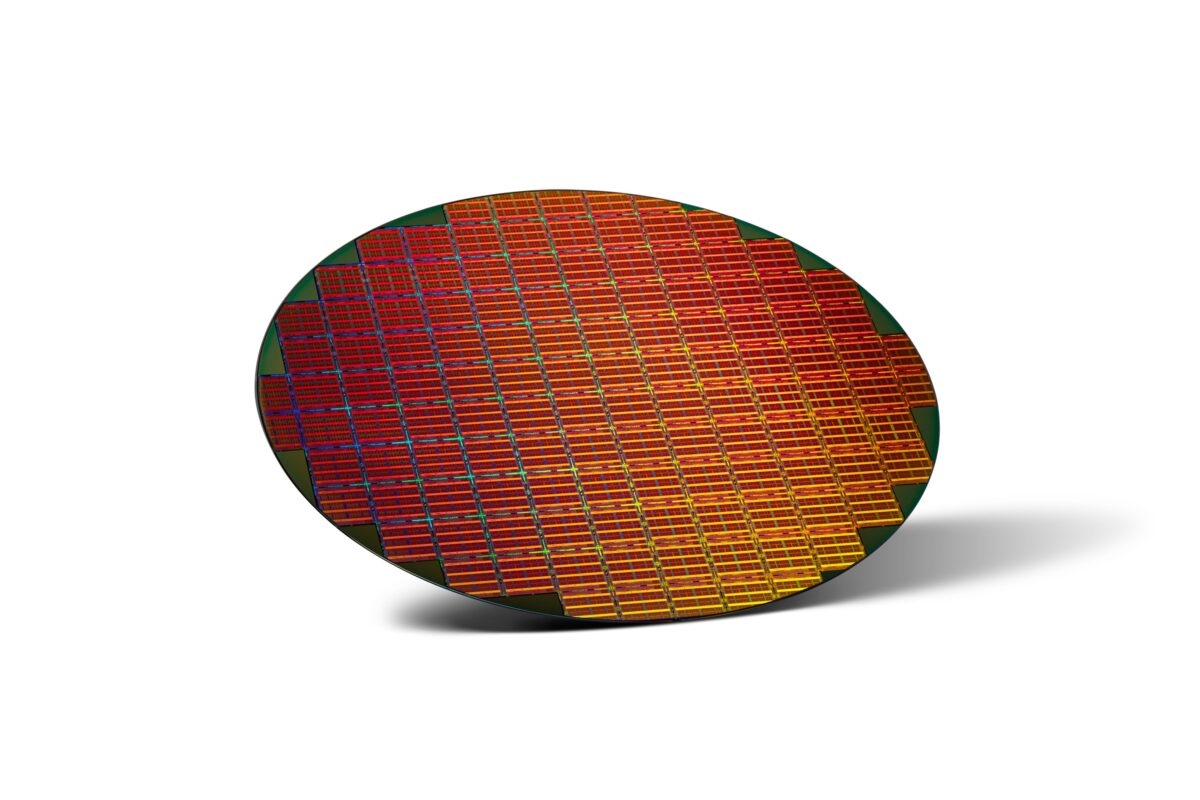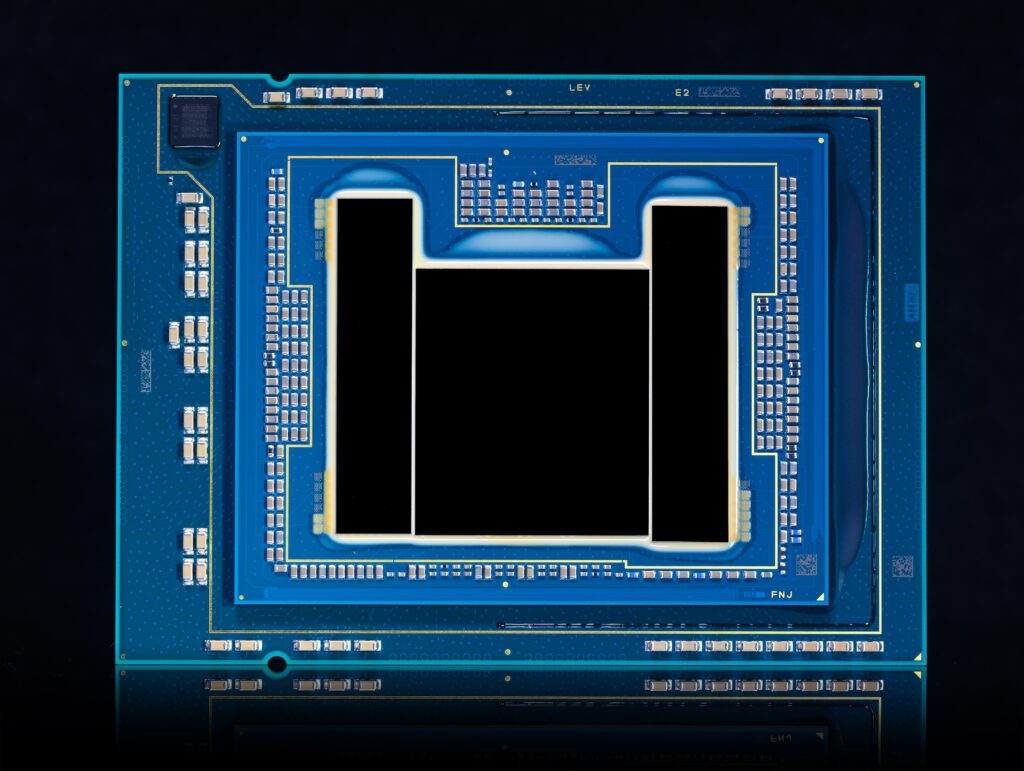Ecosystem Achieves Power Efficiency Breakthrough on Xeon 6 with E-Cores

A photo shows a wafer of Intel Xeon 6 processors with Efficient-cores (code-name Sierra Forest). Intel launched the first member of the Intel Xeon 6 processor family on June 4, 2024, at Computex in Taipei, Taiwan. Intel Xeon 6 with E-cores is optimized for higher performance per watt for throughput-oriented workloads like microservices as well as networking and media. (Credit: Intel Corporation)
Intel Xeon 6 processors with Efficient-cores achieve an unprecedented ecosystem adoption speed by industry-leading 5G core solution partners.
What’s New: Intel today showcased how Intel® Xeon® 6 processors with Efficient-cores (E-cores) have dramatically accelerated time-to-market adoption for the company’s solutions in collaboration with the ecosystem. Since product introduction in June 2024, 5G core solution partners have independently validated a 3.2x performance improvement1, a 3.8x performance per watt increase2 and, in collaboration with the Intel® Infrastructure Power Manager launched at MWC 2024, a 60% reduction in run-time power consumption3.
“As 5G core networks continue to build out using Intel Xeon processors, which are deployed in the vast majority of 5G networks worldwide, infrastructure efficiency, power savings and uncompromised performance are essential criteria for communication service providers (CoSPs). Intel is pleased to announce that our 5G core solution partners have accelerated the adoption of Intel Xeon 6 with E-cores and are immediately passing along these benefits to their customers. In addition, with Intel Infrastructure Power Manager, our partners have a run-time software solution that is showing tremendous progress in reducing server power in CoSP environments on existing and new infrastructure.”
–Alex Quach, Intel vice president and general manager of Wireline and Core Network Division
Why It Matters: Shortening the time to market is invaluable for CoSPs looking to adopt the newest platforms to reap increased energy consumption benefits and reduce their infrastructure footprints while maintaining a pinnacle level of performance. These all represent major challenges that CoSPs face as they modernize networks.
How They Work Better Together: Historically, the ecosystem of virtualized 5G core solutions has relied on certifying solution software on new processor platforms to increase performance and power efficiency. With the Intel Infrastructure Power Manager, solution providers can take advantage of software from Intel to more fully realize the benefits that Intel Xeon processors bring to reducing real-time power consumption. In this way, performance and power-efficiency improvements from new hardware introductions are augmented with additional significant power-saving capabilities from easy-to-deploy software.
About CPU Innovations: Intel's Xeon platforms set the standard in 5G cloud-native core, providing superior total cost of ownership (TCO) and comprehensive power management. Major telecom equipment manufacturers and independent software vendors rely on Intel Xeon processors and architecture to optimize and unleash proven power savings for a more sustainable future.
BT Group: BT Group is the U.K.’s leading provider of fixed and mobile telecommunications and related secure digital products, solutions and services. It aims to accelerate growth through responsible, inclusive and sustainable tech. BT Group’s close collaboration with Intel delivers differentiated 5G infrastructure that is high-performance, cost-optimized and power-efficient. The company says it expects to leverage the capabilities of Intel Xeon 6 with E-cores to enable innovative services for its customers, while simultaneously reducing network energy footprint.
Dell Technologies: The Dell PowerEdge R670 with Intel Xeon 6 processors with E-cores offers an air-cooled, compute-dense server designed to improve performance for 5G core networks. Dell Technologies collaborated with Intel to significantly improve communications service providers time to market, while helping operators reduce infrastructure cost and footprint.
Ericsson: Ericsson Cloud Native Infrastructure Solution (CNIS) enables servers based on Intel Xeon 6 processors with E-cores as a system-verified solution to Ericsson’s entire dual-mode 5G core application portfolio. Ericsson’s packet core products with high-traffic demands will be the leading applications to use it. This helps communication service providers reduce TCO for mobile broadband and fixed wireless deployments that demand high traffic throughput and performance. The close collaboration between Intel and Ericsson has helped to significantly reduce time-to-market introduction of new technology from years to months, and Ericsson’s software optimizations have produced a 3.8x improvement in performance-per-watt2 versus current CoSPs’ deployed configurations.
Hewlett Packard Enterprise: Hewlett Packard Enterprise is maintaining its focus on providing world-class telco platforms and has accelerated its validation cycles to offer HPE ProLiant Compute Gen 12 based on Intel Xeon 6 processors with E-cores. These performance-dense servers consume less power-per-bit than prior generations and will enable operators to continue addressing network growth while reducing their carbon footprint, improving security and simplifying operations.
NEC: NEC provides significant improvement in performance per watt and higher subscriber density for 4G/5G converged core and UPF with Intel Xeon 6 processors with E-cores. NEC will continue to contribute to achieving carbon neutrality through collaboration with Intel.
Nokia: Nokia shows its most power-efficient solution for 5G Packet Core using Intel Xeon 6 processors with E-cores, achieving a 60% reduction in run-time power consumption3 on commercial servers versus existing deployments. Nokia collaborated with Intel to integrate E-core functionalities on its 5G Packet Core NF to scale into more cores, improve performance, and provide operators with a more load- and power-aware solution utilizing Intel Infrastructure Power Manager.
NTT Docomo: NTT Docomo is evaluating options for building its 5G network, focusing on the key criteria of performance per watt and subscriber density. NTT Docomo believes that Intel Xeon 6 processors with E-cores can effectively address the challenges in continuing to expand and enhance its network, while also reducing power consumption and data center footprint.
Samsung: Samsung’s next-generation release of Samsung Cloud Native Core, planned for the second quarter of 2025, will feature Intel Xeon 6 processors with E-cores to deliver 3.2x improvement in performance1 and significant density improvement.
SK Telecom: SK Telecom, as a major step in delivering on its commitment to network sustainability and optimized total cost of ownership, will deploy Hewlett Packard Enterprise DL340 servers based on Intel Xeon 6 processors with E-cores for its 5G core deployments in 2025. In addition to offering 3.2x capacity improvement1 per CPU in a fixed power envelope, the server’s integrated Intel Infrastructure Power Manager will further reduce average power consumption, delivering estimated CPU power savings of 32% per day using SKT’s traffic model.
About Intel Infrastructure Power Manager: Infrastructure Power Manager enhances Intel's leadership in power management by providing operators with millisecond-level core utilization tracking. It enables precise frequency adjustments and CPU power reductions without compromising key performance metrics like throughput, latency and packet drop — saving customers and partners the effort of developing proprietary solutions.
What End Customers Can Do Next: Customers may visit the Intel Booth at MWC 2025 (Hall 3, Booth 3E31) to see demonstrations of the Intel Xeon 6 with E-cores, and how they may work with 5G core solution partners to learn more about the Intel Infrastructure Power Manager.
More Context: Intel Unveils Leadership AI and Networking Solutions with Xeon 6 Processors | Intel Unveils High-Performance, Power-Efficient Ethernet Solutions | Intel Xeon 6 Processors (Press Kit)
The Small Print:
1 Testing by Samsung as of February 2025, 3rd Gen Xeon 6330N vs. Xeon 6 6780E. Results may vary.
2 Testing by Ericsson as of February 2025, versus platform based on 2nd Generation Intel Xeon Processors. Results may vary.
3 Tested with Nokia CMM application as of February 2025, 3rd Gen Xeon 6338N vs. Xeon 6 6780E. Results may vary.
Intel does not control or audit third party data. You should consult other sources to evaluate accuracy.
Performance varies by use, configuration and other factors. Learn more on the Performance Index site.
Performance results are based on testing as of dates shown in configurations and may not reflect all publicly available updates. See backup for configuration details. No product or component can be absolutely secure.
Your costs and results may vary.
Intel technologies may require enabled hardware, software or service activation.




